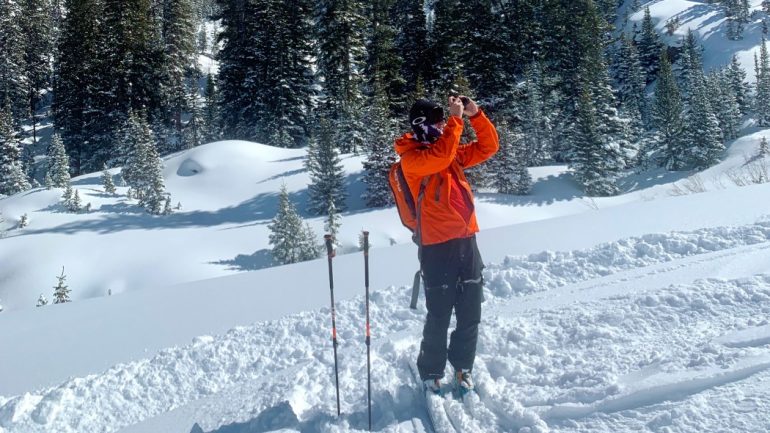
For most backcountry tourers these days, pulling a phone out to snap a photo is just as common as taking a sip of water and often followed by posting to social media.
Examining the influence of social media on backcountry skiers
In today’s day and age, are you ever truly alone? Even in some of the world’s most remote places, human interaction is just the press of a button away. Whether you are on top of the tallest mountain on earth, or deep in the ocean, you can make your actions visible to others if you choose to. In this incredibly connected world, physical interactions are no longer required to influence heuristics. Instead, there is an invisible pressure that amplifies our innate biases. So while social media can be an incredibly positive tool, we must be diligent to understand the role that Instagram and Facebook play not only in our own decision making process, but the influence it might have on others.
Social media has been front and center during the last months of COVID-19 when, for arguably the first time in our sport’s history, we have had to make the conscious decision to dial back our skiing for the greater good of the community. People have grappled with the question of whether or not they should go skiing and if they do, whether or not they should post about it. Not only does skiing pose a risk to a strained medical system, but posting about it can have an impact on others’ behavior.
In an effort to better understand our communities’ relationship with social media, I surveyed 39 backcountry skiers who are active on Instagram. My goal with this survey was to gain a better understanding of the habits and sentiment people have with these platforms. The survey included questions such as ‘how often do you post on social media about your backcountry skiing’ and ‘how soon after your backcountry ski do you typically post’. With everything going on in the world, this is certainly an interesting time to be writing about this topic.
I also caught up with Eric Henderson, a former guide, CEO of an outdoor PR company and one of the founders of #curbyourturns — an initiative put forward by Snowsports Industry America last month that urged people to stop skiing to protect the greater public health. The hashtag gained popularity and has been posted by notable skiers in an effort to limit strain on health resources.
This initiative is especially important when considering the fact that inexperienced backcountry skiers have a lot of time on their hands and no lifts to ride. “It’s the equivalent of FOMO,” said Henderson “if you go on snapchat on a Saturday night and you’re missing a big party, [it’s like] wishing you were skiing in the Tetons come January because your feed is filled with deep powder skiing.” Pandemic or not, if you are out skiing sick lines and then posting about it, is that enough to trigger a fear of missing out (FOMO) in other less experienced backcountry skiers? If so, it can be worrisome – especially when social media posts oftentimes tell a misleading story, a common issue with Instagram.
“That is where social media is specifically a trap. The one photo of the one skier doesn’t show the whole story. It doesn’t take into account the group dynamics and decision making that went into that photo,” said Henderson. To make matters more complicated, 16 of the 39 backcountry skiers we surveyed reported posting photos ‘one week or more’ or ‘at random times’ after skiing. So while the more experienced backcountry skier knows to take Instagram ‘beta’ with a big grain of salt, less experienced backcountry skiers might not.
These concerns are shared by others. In our survey, 44% of people felt that social media impacted their own decision making, but 97% of people felt social media impacted other people’s decision making. With the majority of our participants being avid backcountry skiers, it’s possible that their experience in combating bias gives them the ability to combat social media’s influence. However, it’s naiive to think that social media has zero impact.

Tom enjoying some spring colorado powder. Taken out of context on social media, the photo offers little useful information other than the snow was deep that one day…
At the end of the day, what’s most worrisome about social media is that it has a disproportionate impact on less experienced backcountry skiers. These users haven’t had time to develop the tools to combat decision bias, and are therefore the most susceptible. So what responsibility does the more experienced skier have when posting on social media? Henderson expressed that “the experienced skier has the responsibility to share more about the observations that were seen during their ski.” In addition to skiers being more informative on social media, there needs to be a continued emphasis in avalanche education that Instagram ‘beta’ needs to be taken with a grain of salt.
Since our new ultra-connected world doesn’t seem to be going anywhere soon, we must work together as a backcountry community to utilize social media platforms for good. We need to share observations, be transparent with our content and educate the next generation. We need to understand that when you use social media, it is going to impact you and your followers- whether you like it or not. Lastly, we need to know that social media isn’t evil, it’s just the new normal.
Tom Bull is a resident of Minturn, Colorado where he enjoys harvesting low angled powder and high angled corn. He recently completed a two-year Avalanche Science program through Colorado Mountain College where his passion and curiosity about snow has only grown. You can connect with him on Instagram @_nobullshit_
